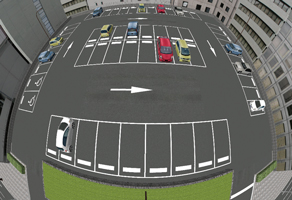This plug-in renders all directions around the camera in UC-win/Road, and
creates simulation result image accordingt to the camera parameter in the
result. As for the fisheye lens' projection method, it supports "Equidistance
projection", "Equisolid angle projection", "Stereographic
projection", and "Orthogonal projection". From the information
of "number of pixel", "cell size", "focus distance",
and projection method, it calculates and arranges the height of the image
and the camera direction at the sensor position and generates camera images.
More various camera simulations are available by defining the angle and
image height processing by polynomial, or the distortion table file by
CSV file, in addition to the setting by these projection methods and parameters.
This plug-in can be utilized for a lot of ways such as R&D of camera
sensors and examination of location and performance of security cameras. |
|
 |
 Fig.2 Examination of location of security cameras Fig.2 Examination of location of security cameras |
|
